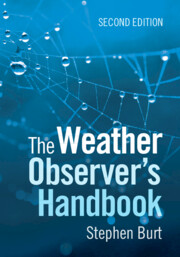Book contents
- The Weather Observer’s Handbook
- Reviews
- The Weather Observer’s Handbook
- Copyright page
- Dedication
- Epigraph
- Contents
- Foreword
- Acknowledgements
- Author’s note
- Abbreviations, footnotes and references
- Part I The basics
- Part II Measuring the weather
- Part III Making the most of your observations
- 17 Collecting and storing data
- 18 Making the data avalanche work for you
- 19 Sharing your observations
- 20 Summary and getting started
- Book part
- References and Further Reading
- Index
17 - Collecting and storing data
from Part III - Making the most of your observations
Published online by Cambridge University Press: 21 May 2024
- The Weather Observer’s Handbook
- Reviews
- The Weather Observer’s Handbook
- Copyright page
- Dedication
- Epigraph
- Contents
- Foreword
- Acknowledgements
- Author’s note
- Abbreviations, footnotes and references
- Part I The basics
- Part II Measuring the weather
- Part III Making the most of your observations
- 17 Collecting and storing data
- 18 Making the data avalanche work for you
- 19 Sharing your observations
- 20 Summary and getting started
- Book part
- References and Further Reading
- Index
Summary
Making best use of collected weather observations is simplified where thought is given to record management and storage: gathering meteorological records is usually a means to an end, rather than an end in itself. The more effectively records are stored, the quicker and easier it becomes to analyse and use them productively – a statement which applies equally to both professional and amateur observers. This chapter provides tried and tested suggestions for collecting, storing and archiving data from both manual observations and automatic weather stations (AWSs).
Keywords
- Type
- Chapter
- Information
- The Weather Observer's Handbook , pp. 363 - 377Publisher: Cambridge University PressPrint publication year: 2024

